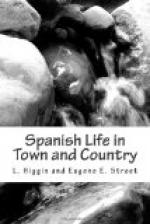In the earlier stages of railway construction and management, French capital and French labour were employed. England held aloof, partly on account of the closing of the London Stock Exchange to Spanish enterprises, in consequence of the vexed question of the celebrated coupons, but also because the aid afforded by the State did not fall in with the ideas of English capitalists. They desired a guaranteed rate of interest, while the Spanish Government would have nothing but a subvention paid down in one lump sum, arguing that it would be impossible to tell when a line was making more than the guaranteed interest, “as the companies would so arrange their accounts as to show invariably an interest smaller than that guaranteed!” With this view of the honesty of their own officials, no one else could be expected to have a better opinion of them; and England allowed France and Belgium thenceforward to find all the capital and all the materials for Spanish railways.
The total amount of subventions actually paid by Government up to December 31, 1882, was L24,529,148. “If,” says the author of Commercial and Industrial Spain, “the money that we so candidly lent to the swarm of defaulting South American Republics had been properly invested in Spanish railways, a great deal of trouble might probably have been spared to the unfortunate investors.”
All that, however, is altered now: the State schools and universities are turning out daily well-equipped native engineers, both for railway and mining works, and Spaniards are finding their own capital for public works. The phrase “Spain for the Spaniards” is acquiring a new significance—perhaps the most hopeful of all the signs of progress the country is making. In 1899, there were working 12,916 kilometros of railways, or 7.9 kilometros for each 10,000 of the population. A kilometro equals 1.609 English mile. There is no part of the country now isolated, either from the centre of government in Madrid, or from the coast, and communication with Portugal, and, through France, with the rest of Europe, is easy and constant. With this advance in means of transit, the trade of the country has received an immense impulse, and its raw and manufactured goods are now reaching all markets.
The rich mineral wealth of the country and its wonderful climate only need enlightened enterprise to make Spain one of the richest and most important commercial factors in the world’s trade. The list of minerals alone, raised from mines in working, amounts to twenty-two, ranging from gold and silver, copper, tin, zinc, quick-silver, salt, coal, etc., to cobalt and antimony; and 8,313,218 tons of minerals of all these twenty-two classes were raised in 1882 against 1,201,054 in 1862. The value of mines in 1880 was represented by one hundred and eleven millions of pesetas (francs), but in 1898 by three hundred and nineteen millions (pesetas). The value of imports in 1882 was 816,666,901 pesetas, and of exports 765,376,087 pesetas. In 1899, imports were 1,045,391,983, and exports 864,367,885. But this is taking exactly the period covered by the war with America; a fairer estimate of exports is that of 1897, which stood at 1,074,883,372. No statement has been published since 1899, but intermediate statistics show the trade of the country to be advancing rapidly.




